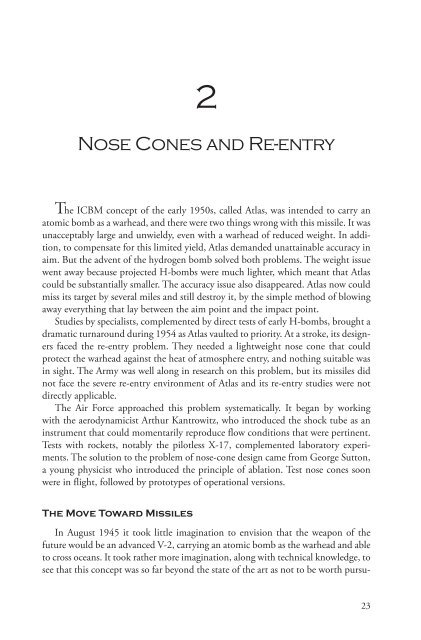Facing the Heat Barrier - NASA's History Office
Facing the Heat Barrier - NASA's History Office
Facing the Heat Barrier - NASA's History Office
You also want an ePaper? Increase the reach of your titles
YUMPU automatically turns print PDFs into web optimized ePapers that Google loves.
The ICBM concept of <strong>the</strong> early 1950s, called Atlas, was intended to carry an<br />
atomic bomb as a warhead, and <strong>the</strong>re were two things wrong with this missile. It was<br />
unacceptably large and unwieldy, even with a warhead of reduced weight. In addition,<br />
to compensate for this limited yield, Atlas demanded unattainable accuracy in<br />
aim. But <strong>the</strong> advent of <strong>the</strong> hydrogen bomb solved both problems. The weight issue<br />
went away because projected H-bombs were much lighter, which meant that Atlas<br />
could be substantially smaller. The accuracy issue also disappeared. Atlas now could<br />
miss its target by several miles and still destroy it, by <strong>the</strong> simple method of blowing<br />
away everything that lay between <strong>the</strong> aim point and <strong>the</strong> impact point.<br />
Studies by specialists, complemented by direct tests of early H-bombs, brought a<br />
dramatic turnaround during 1954 as Atlas vaulted to priority. At a stroke, its designers<br />
faced <strong>the</strong> re-entry problem. They needed a lightweight nose cone that could<br />
protect <strong>the</strong> warhead against <strong>the</strong> heat of atmosphere entry, and nothing suitable was<br />
in sight. The Army was well along in research on this problem, but its missiles did<br />
not face <strong>the</strong> severe re-entry environment of Atlas and its re-entry studies were not<br />
directly applicable.<br />
The Air Force approached this problem systematically. It began by working<br />
with <strong>the</strong> aerodynamicist Arthur Kantrowitz, who introduced <strong>the</strong> shock tube as an<br />
instrument that could momentarily reproduce flow conditions that were pertinent.<br />
Tests with rockets, notably <strong>the</strong> pilotless X-17, complemented laboratory experiments.<br />
The solution to <strong>the</strong> problem of nose-cone design came from George Sutton,<br />
a young physicist who introduced <strong>the</strong> principle of ablation. Test nose cones soon<br />
were in flight, followed by prototypes of operational versions.<br />
The Move Toward Missiles<br />
2<br />
Nose Cones and Re-entry<br />
In August 1945 it took little imagination to envision that <strong>the</strong> weapon of <strong>the</strong><br />
future would be an advanced V-2, carrying an atomic bomb as <strong>the</strong> warhead and able<br />
to cross oceans. It took ra<strong>the</strong>r more imagination, along with technical knowledge, to<br />
see that this concept was so far beyond <strong>the</strong> state of <strong>the</strong> art as not to be worth pursu-<br />
23
















